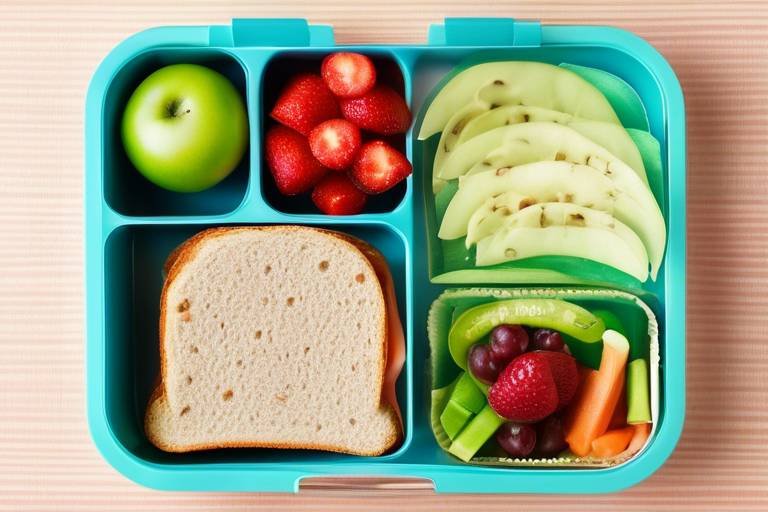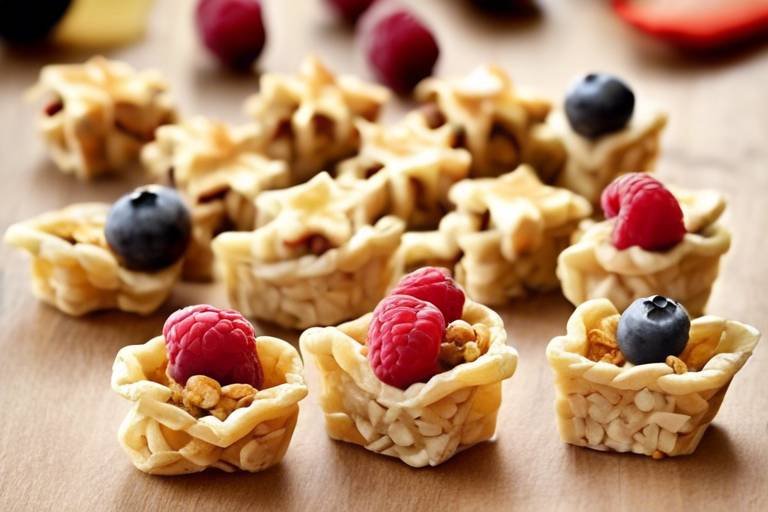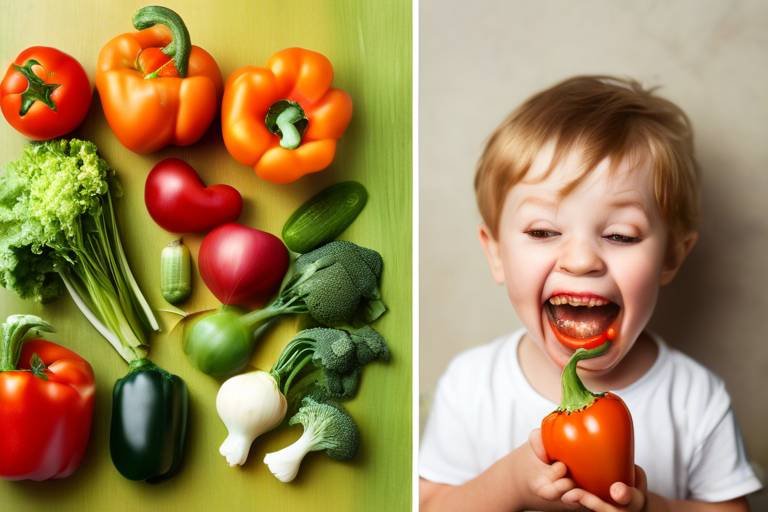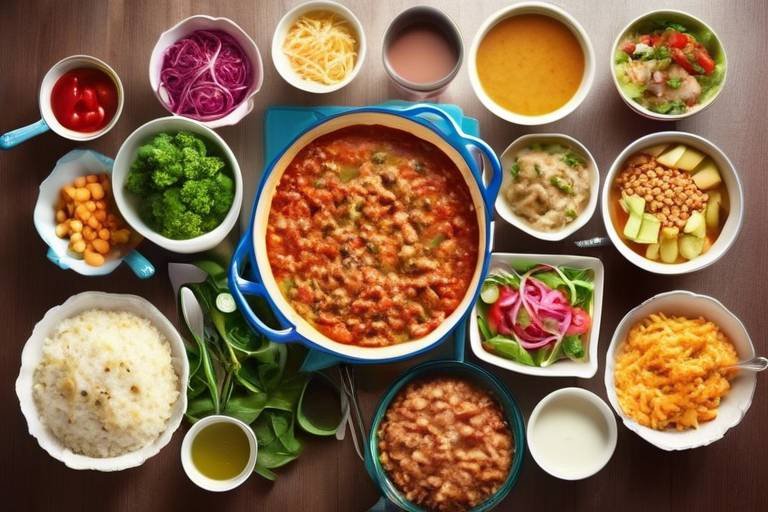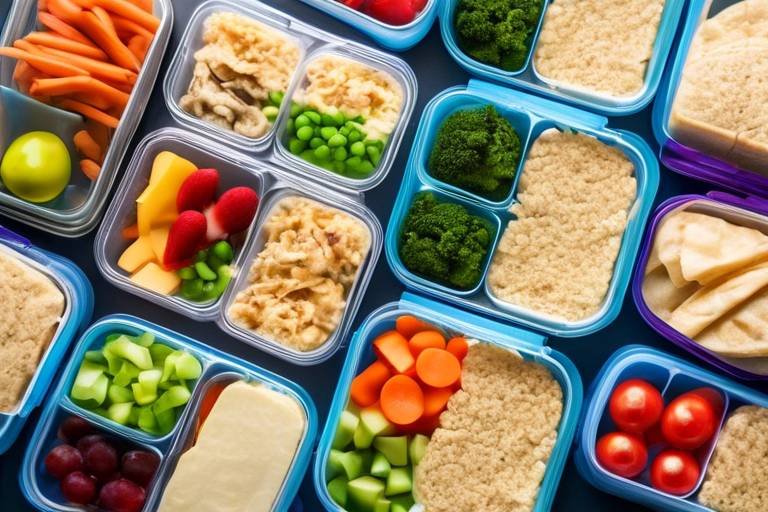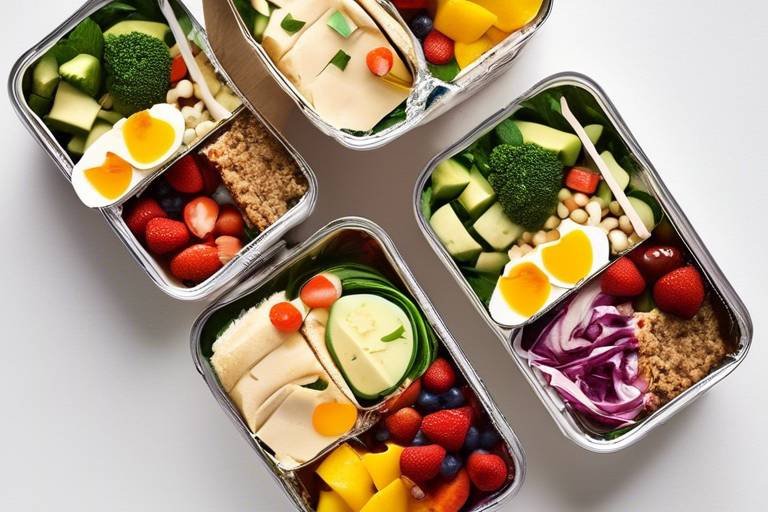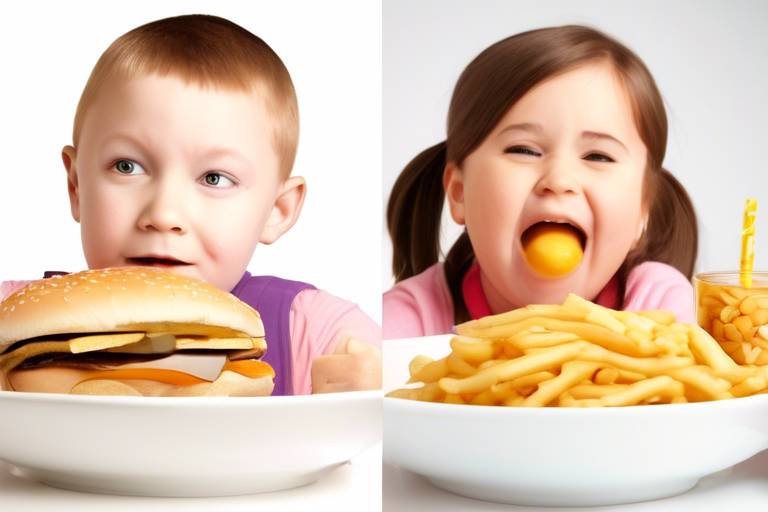Guide to Healthy School Lunches: Your Kids Will Love These Ideas
As parents, we all want our kids to eat healthy, right? But let’s be real—getting them excited about nutritious meals can sometimes feel like pulling teeth! The good news is that with a little creativity and planning, you can whip up delicious and nutritious school lunches that your kids will actually look forward to. Imagine their faces lighting up when they open their lunchboxes to find a colorful, fun meal instead of the usual boring sandwich! In this guide, we’ll explore various healthy lunch ideas that not only meet their nutritional needs but also make lunchtime a delightful experience.
Before diving into the fun stuff, let’s talk about what our kids really need to grow strong and stay focused in school. Kids require a balanced intake of essential nutrients, including carbohydrates for energy, proteins for growth, fats for brain development, and a plethora of vitamins and minerals for overall health. So, how do we incorporate these into their lunches? It’s simpler than you might think! By focusing on whole foods—fresh fruits, vegetables, lean meats, and whole grains—you can create meals that are not only healthy but also appealing to their taste buds.
Now that we understand the nutritional needs, let’s get to the fun part! Here are some exciting lunch ideas that are as visually appealing as they are nutritious. Kids are naturally drawn to bright colors and interesting shapes, so why not use that to your advantage? A lunch that looks good is half the battle won!
How about starting with colorful veggie wraps? These wraps are not only vibrant but also packed with nutrients. Picture this: a whole grain tortilla filled with a rainbow of vegetables like carrots, bell peppers, spinach, and cucumbers. Not only do they look fantastic, but they also provide a variety of vitamins and minerals. Plus, they’re easy to make! Just load up the tortilla with your child’s favorite veggies, roll it up, and voilà! You’ve got a lunch that’s both healthy and fun.
When it comes to choosing ingredients for your veggie wraps, freshness is key. Look for organic vegetables when possible and aim for a mix of textures and flavors. For instance, adding some crunchy bell peppers with creamy avocado can create a delightful eating experience. Here’s a quick guide:
| Vegetable | Benefits |
|---|---|
| Spinach | Rich in iron and vitamins A and C |
| Carrots | Great source of beta-carotene, good for eyesight |
| Cucumbers | Hydrating and low in calories |
| Bell Peppers | High in vitamin C and adds sweetness |
To make those veggie wraps even more enticing, consider adding some creative dipping sauces. A simple yogurt dip or a homemade hummus can elevate the flavor and encourage kids to enjoy their veggies even more. Plus, dipping can make eating more interactive and fun!
Let’s not forget about protein! It’s crucial for keeping our kids feeling full and energized throughout the school day. Think turkey roll-ups, bean salads, or even hard-boiled eggs. These options are not only tasty but also easy to prepare. For example, you can roll turkey slices around some cheese and veggies for a quick, satisfying meal. It’s like a mini protein party in their lunchbox!
Whole grains are another essential component of a healthy school lunch. They provide sustained energy and are packed with fiber, which is great for digestion. Consider including whole grain bread in sandwiches or even using brown rice in salads. The key is to make it interesting! Whole grains can be just as fun as their refined counterparts when presented creatively.
Speaking of sandwiches, let’s talk about some whole grain bread options. You can find everything from whole grain sourdough to multigrain wraps. Fill them with lean proteins, fresh veggies, and maybe a slice of cheese for a delicious meal. The possibilities are endless!
Lastly, don’t forget about snacks! Healthy snacks can complement school lunches perfectly. Think about whole grain crackers, yogurt with fruit, or even homemade energy balls. These snacks will keep your kids fueled and satisfied throughout the day.
- What are some quick lunch ideas for busy mornings? Try preparing wraps or sandwiches the night before, and keep them in the fridge. You can also pack fruits and veggies in advance!
- How can I encourage my kids to try new foods? Get them involved in the kitchen! Let them help with meal prep and choose ingredients. Kids are more likely to eat what they’ve helped create.
- Are there any healthy dessert options? Absolutely! Consider fruit salads, yogurt parfaits, or even homemade oatmeal cookies as a sweet treat.

Understanding Nutritional Needs
When it comes to keeping our little ones healthy and happy, understanding their nutritional needs is vital. Children are like little engines, constantly running, playing, and learning. To fuel this energy, they require a balanced diet rich in essential nutrients. These nutrients include carbohydrates, proteins, fats, vitamins, and minerals. Each plays a unique role in supporting their growth and development, making it crucial to incorporate a variety of foods into their school lunches.
Let's break it down a bit. Carbohydrates are the body's primary energy source, and they can be found in foods like whole grains, fruits, and vegetables. Think of them as the fuel that keeps your child's engine running smoothly throughout the school day. Next up, we have proteins, which are essential for building and repairing tissues. They can be sourced from meats, beans, nuts, and dairy products. Imagine proteins as the construction workers that help build and maintain your child’s growing body.
Now, let’s not forget about fats. While fats often get a bad rap, healthy fats found in avocados, nuts, and fish are crucial for brain development and overall health. They act like the oil that keeps the engine running efficiently. Additionally, vitamins and minerals are the unsung heroes of nutrition. They support a myriad of bodily functions, from immune health to bone strength. Including a rainbow of fruits and vegetables in your child's lunch can help ensure they get a wide range of these essential nutrients.
To help parents navigate this nutritional landscape, here’s a quick overview of the essential nutrients and their benefits:
| Nutrient | Sources | Benefits |
|---|---|---|
| Carbohydrates | Whole grains, fruits, vegetables | Provides energy for daily activities |
| Proteins | Meats, beans, nuts, dairy | Supports growth and tissue repair |
| Fats | Avocados, nuts, fish | Essential for brain development |
| Vitamins | Fruits, vegetables | Supports immune function and overall health |
| Minerals | Dairy, leafy greens, nuts | Important for bone health and metabolic processes |
Incorporating these nutrients into school lunches doesn’t have to be a chore. It can be a fun adventure! Think of it as a colorful journey where each meal is a new destination. By mixing and matching different food groups, you can create meals that are not only nutritious but also appealing to your child’s taste buds. Remember, the goal is to keep their lunches exciting and varied, ensuring they receive the nutrients they need to thrive.
So, the next time you pack that lunchbox, consider the nutritional needs of your child. With a little creativity and a sprinkle of fun, you can provide them with meals that fuel their bodies and minds, setting them up for a day full of learning and play!

Fun and Engaging Lunch Ideas
When it comes to making school lunches that kids will actually want to eat, creativity is key! Gone are the days of boring sandwiches and wilted salads. Instead, let’s dive into a world of colorful, fun, and nutritious options that will make lunchtime the highlight of their day. Imagine opening up a lunchbox to find a vibrant array of foods that not only look good but taste amazing too! This is the kind of excitement we want to inspire in our kids.
One fantastic way to keep lunches engaging is by incorporating a variety of colors and textures. Kids are naturally drawn to bright colors, so why not use that to our advantage? For example, colorful veggie wraps can be a hit. You can use whole grain tortillas and fill them with a rainbow of vegetables like red bell peppers, purple cabbage, yellow carrots, and green spinach. The visual appeal alone can spark their curiosity and encourage them to dig in!
Creating these wraps is simple! Just grab some whole grain tortillas and let your child help pick out their favorite veggies. You could even turn it into a fun activity by setting up a little “wrap station” at home, complete with various toppings like hummus, cheese, or even some grilled chicken for added protein. Not only does this empower them to make their own choices, but it also teaches them about healthy eating in a hands-on way. Plus, who doesn’t love a good wrap?
When selecting ingredients for these wraps, think about freshness and variety. Look for seasonal vegetables at your local market for the best flavor and nutrients. Incorporating different textures is also essential; crunchy veggies like cucumbers or carrots paired with creamy dips can make for an exciting bite. Remember, the more vibrant the colors, the more appealing it will be to your child!
To take these wraps to the next level, consider adding some creative dipping sauces. Kids love to dip, and this can make eating veggies much more enjoyable. You can whip up a quick yogurt-based ranch dip or a zesty hummus. Not only do these sauces enhance the flavor, but they also provide additional nutrients. You can even involve your kids in making these dips, letting them experiment with flavors and ingredients!
Another engaging lunch idea is to create protein-packed options that keep them full and energized throughout the day. Think turkey roll-ups or bean salads that are both tasty and healthy. For turkey roll-ups, simply roll slices of turkey around some cheese and veggies. These are easy to make, fun to eat, and packed with protein!
Don’t forget about the importance of incorporating whole grains into your child’s lunch. Whole grains are not just good for you; they’re also delicious! Use whole grain bread for sandwiches or include quinoa or brown rice in salads. The nutty flavor and chewy texture of whole grains can elevate a simple meal into something extraordinary.
When it comes to sandwiches, the possibilities are endless! You can use whole grain bread and fill it with various ingredients that your kids love. Think outside the box by adding things like avocado, spinach, or even a spread of hummus to make it more appealing. You can also create fun shapes with cookie cutters, turning an ordinary sandwich into a delightful surprise!
Finally, let’s not overlook the snacks! Healthy snacks can complement school lunches perfectly. Consider options like whole grain crackers with cheese, yogurt with fruit, or homemade energy balls made from oats and nut butter. These snacks not only keep kids energized but also ensure they’re getting the nutrients they need to stay focused and active throughout the school day.
In conclusion, making school lunches fun and engaging doesn’t have to be a chore. By incorporating colorful ingredients, creative recipes, and whole grains, you can create meals that your kids will love and that will nourish their growing bodies. So, let’s get creative and make lunchtime an adventure!
Q: How can I get my kids to eat more vegetables?
A: Involve them in the preparation process and make veggies fun by using colorful dips and creative presentations.
Q: What are some easy whole grain options for school lunches?
A: Whole grain breads, brown rice, quinoa, and whole grain crackers are all excellent choices.
Q: How can I make lunch prep easier during busy mornings?
A: Prepare lunches the night before and involve your kids in choosing their lunch items to streamline the process.

Colorful Veggie Wraps
When it comes to packing a lunch that your kids will actually look forward to, are a game changer! Not only are they bursting with flavor and nutrition, but they also provide a visual feast that can make even the pickiest eaters excited about their meals. Imagine opening up a lunchbox to find a vibrant wrap filled with a rainbow of veggies—it's like a party for their taste buds! But how do you create these delightful wraps? Let's dive into the art of crafting the perfect veggie wrap that your kids will love.
First, the base of your wrap is crucial. Opt for whole grain tortillas as they are packed with fiber, which helps keep those little tummies full and satisfied throughout the school day. Whole grains are not just healthier; they also add a delightful texture that complements the crunch of fresh veggies. Now, let’s talk about the filling! The beauty of veggie wraps lies in their versatility. You can use any combination of vegetables that your child enjoys. Here are some ideas to get you started:
- Bell Peppers: Slice them into thin strips for a sweet crunch.
- Cucumbers: They add a refreshing crunch and are super hydrating.
- Carrots: Grated or cut into sticks, they bring a nice sweetness.
- Spinach or Lettuce: For a fresh, leafy element.
- Avocado: Creamy and packed with healthy fats!
Now that you have your ingredients, it’s time to assemble your wrap. Start by spreading a thin layer of hummus or cream cheese on the tortilla. This not only adds flavor but also acts as a glue to hold everything together. Next, layer your chosen vegetables in a colorful array, making sure to leave some space at the edges for easy rolling. Once you’ve piled on the veggies, roll the tortilla tightly, tucking in the sides as you go. This will help keep all those delicious fillings from spilling out when your child digs in during lunch!
But wait, there’s more! To make these wraps even more enticing, consider adding a few creative dipping sauces. A simple yogurt-based dip or a tangy vinaigrette can elevate the flavors and make eating veggies a lot more fun. Here are a couple of easy recipes:
| Dipping Sauce | Ingredients | Instructions |
|---|---|---|
| Yogurt Dip | 1 cup plain yogurt, 1 tbsp lemon juice, 1 tsp garlic powder, salt to taste | Mix all ingredients in a bowl until smooth. |
| Honey Mustard | 2 tbsp mustard, 1 tbsp honey, 1 tbsp olive oil | Whisk together until well combined. |
Encouraging your kids to eat healthy can sometimes feel like a daunting task, but with colorful veggie wraps, you’re not just feeding them—you’re making a statement! These wraps are not only visually appealing but also packed with essential nutrients that support their growth and learning. Plus, they're a fantastic way to introduce new flavors and textures into their diet without overwhelming them. So, next time you're packing lunch, remember the vibrant world of veggie wraps. Your kids will thank you for it!
In conclusion, colorful veggie wraps are a simple yet effective way to create a nutritious lunch that your children will love. With a little creativity and some fun ingredients, you can transform lunchtime into a delightful experience that nourishes their bodies and minds.
Q: Can I prepare veggie wraps the night before?
A: Absolutely! Just make sure to wrap them tightly in plastic wrap or foil to keep them fresh. You might want to add the dressing or dips separately to prevent sogginess.
Q: What if my child doesn't like certain vegetables?
A: No problem! Feel free to swap out any veggies for those your child enjoys. The goal is to make it appealing to them.
Q: Are these wraps suitable for a school that has a nut-free policy?
A: Yes! Just be mindful of any nut-based ingredients in your dips or spreads.

Choosing the Right Ingredients
When it comes to crafting the perfect veggie wrap for your child's school lunch, the ingredients you choose can make all the difference. It's not just about filling a tortilla; it's about creating a delightful and nutritious experience that will have your child excited to dive into their lunchbox. Start with a base of whole grain tortillas—they provide essential fiber and nutrients that refined options lack. Think of whole grains as the sturdy foundation of a house; without them, everything else might crumble.
Next, consider the colorful vegetables that will fill those wraps. The more colors you incorporate, the more nutrients you’re providing. For instance, vibrant red bell peppers are rich in vitamin C, while spinach offers iron and calcium. You might even want to include some shredded carrots for a sweet crunch or avocado for healthy fats. These ingredients not only enhance the nutritional profile but also make the wrap visually appealing. Just like a painter uses a variety of colors to create a masterpiece, you can use different vegetables to create a lunch that’s a feast for the eyes as well as the stomach.
Don’t forget about adding a source of protein. Options like hummus, grilled chicken, or even black beans can turn your veggie wrap into a well-rounded meal that keeps your child full and energized throughout the day. Think of protein as the glue that holds everything together—without it, the wrap might just fall apart, both literally and figuratively!
Lastly, consider the flavors and textures. Mixing crunchy vegetables with creamy ingredients like hummus or yogurt-based dressings can create an exciting eating experience. You might want to experiment with different herbs and spices to add depth to the flavor. A sprinkle of cumin or a dash of lemon juice can elevate the taste profile and make those veggies even more enticing. Remember, the goal is to create a wrap that not only nourishes but also delights your child's taste buds!
In summary, when choosing ingredients for your veggie wraps, focus on:
- Whole grains for a nutritious base
- Colorful vegetables for vitamins and minerals
- Protein sources to keep kids full
- Flavor and texture for an enjoyable eating experience
By thoughtfully selecting these components, you can craft a veggie wrap that your child will love, ensuring lunchtime is both exciting and nourishing!
Q1: Can I use any type of tortilla for veggie wraps?
A1: While you can use any tortilla, whole grain options are recommended for added fiber and nutrients. They provide a healthier base compared to refined flour tortillas.
Q2: What if my child doesn’t like certain vegetables?
A2: It's all about experimentation! Try introducing new veggies in different forms, like shredded or diced, and pair them with dips or sauces they enjoy. You might be surprised by what they end up liking!
Q3: How can I keep the wraps fresh until lunchtime?
A3: Wrap them tightly in foil or parchment paper and store them in an insulated lunch bag with an ice pack to maintain freshness and prevent sogginess.

Creative Dipping Sauces
When it comes to making veggies more appealing, dipping sauces can be a game-changer! Kids often love to dip their food, and introducing a variety of delicious sauces can make healthy eating feel like a fun adventure rather than a chore. Imagine a colorful plate of fresh veggies paired with a creamy ranch or a zesty hummus—suddenly, those carrots and bell peppers become the stars of lunchtime!
Here are a few creative dipping sauce ideas that not only taste great but also pack a nutritional punch:
- Avocado Yogurt Dip: Blend ripe avocados with plain Greek yogurt, a squeeze of lime, and a pinch of salt. This creamy dip is rich in healthy fats and protein, making it a fantastic choice for your little ones.
- Sweet and Spicy Mango Salsa: Combine diced mango, red onion, jalapeño, and cilantro for a tropical twist. This fresh salsa adds a burst of flavor and is loaded with vitamins.
- Peanut Butter and Soy Sauce: Mix natural peanut butter with a dash of soy sauce and a hint of honey for a savory and slightly sweet dip. It’s perfect for pairing with crunchy veggies like celery and bell peppers.
These sauces not only enhance the flavor of the veggies but also encourage kids to experiment with their food. It’s like turning lunchtime into a mini culinary experience! You can even involve your kids in the preparation process; let them choose their favorite ingredients to create their own unique dipping sauces. This not only fosters creativity but also helps them understand the importance of nutrition.
Additionally, consider presenting these sauces in small, colorful containers, making them visually appealing. You could even create a dipping sauce bar at home, where kids can mix and match their favorite sauces with different veggie options. This interactive approach can transform lunchtime into a fun activity that they'll look forward to every day!
Incorporating these creative dipping sauces into your child's lunch can significantly enhance their eating experience. Not only do they add flavor, but they also encourage kids to consume more vegetables, leading to healthier eating habits in the long run. So, why not spice up their lunch with some exciting dips? Your kids will thank you for it!
1. What are some other healthy dipping sauce options?
You can try tzatziki, a yogurt-based sauce with cucumber and garlic, or a simple olive oil and balsamic vinegar mix. Both are delicious and healthy!
2. Can I prepare these sauces in advance?
Absolutely! Most of these sauces can be made ahead of time and stored in the refrigerator for up to a week. Just make sure to keep them in airtight containers.
3. How can I encourage my kids to try new sauces?
Make it fun! Offer taste tests with a variety of sauces and let your kids rate them. This way, they feel involved and are more likely to try new flavors.
4. Are these sauces suitable for kids with allergies?
Always check the ingredients for potential allergens. For instance, if your child has a peanut allergy, you can substitute peanut butter with sunflower seed butter.

Protein-Packed Options
When it comes to fueling our little ones for a busy school day, are a game changer. Not only do they provide the energy kids need to stay active and focused, but they also help keep hunger at bay until the next meal. Think of protein as a superhero that swoops in to save the day, keeping your child satisfied and ready to tackle their studies. So, what are some delicious ways to incorporate protein into your child's lunch? Let’s dive in!
One fantastic option is turkey roll-ups. These are incredibly simple to make and can be customized to suit your child’s taste. Just take a slice of turkey, add a smear of cream cheese or hummus, throw in some spinach or sliced bell peppers, and roll it all up! Not only does this provide a protein punch, but it also adds a colorful crunch that kids will love. Plus, you can pair these roll-ups with a side of whole grain crackers to give them that extra boost of energy.
Another protein-rich option is a bean salad. Yes, you heard it right! Beans are not just for chili anymore. You can create a vibrant salad using black beans, kidney beans, and chickpeas, tossed with some diced tomatoes, corn, and a drizzle of olive oil and lime juice. Not only is this salad packed with protein, but it also delivers a hearty dose of fiber, which is essential for digestive health. Serve it in a fun container, and watch your kids dig in!
If your child is a fan of dips, consider adding a Greek yogurt dip to their lunchbox. Greek yogurt is not only creamy and delicious but also loaded with protein. You can mix it with herbs and spices to create a savory dip that pairs perfectly with veggies or whole grain pita chips. This not only makes for a fun and interactive lunch but also encourages kids to munch on their veggies!
For those days when you want something quick and easy, hard-boiled eggs can be a lifesaver. They are portable, easy to prepare, and packed with protein. You can even slice them up and add them to a whole grain wrap or salad for an extra protein boost. Plus, they are a great source of essential nutrients like vitamin D and choline, which are vital for your child's growth and brain development.
Lastly, don’t forget about nut butters. Whether it's almond, peanut, or sunflower seed butter, these spreads are not only delicious but also provide a good amount of protein. Spread them on whole grain bread, apple slices, or even celery sticks for a fun and nutritious snack. Just be sure to choose natural nut butters without added sugars for the healthiest option.
Incorporating these protein-packed options into your child's lunch will not only keep them full and satisfied but also help them perform their best in school. Remember, a well-balanced meal is key to ensuring your little ones have the energy they need to learn and grow. So, get creative, have fun with flavors, and watch your kids enjoy their meals while getting the nutrition they need!
Q: How much protein do kids need daily?
A: The amount of protein children need can vary based on their age, sex, and level of physical activity. Generally, children aged 4-8 need about 19 grams of protein per day, while those aged 9-13 need around 34 grams. It’s essential to include a variety of protein sources in their diet.
Q: Can I use plant-based proteins for my child's lunch?
A: Absolutely! Plant-based proteins like beans, lentils, tofu, and quinoa are excellent options. They not only provide protein but also come packed with fiber and other essential nutrients.
Q: Are protein bars a good option for school lunches?
A: While protein bars can be a convenient snack, it's important to choose ones that are low in added sugars and made with whole ingredients. Homemade protein bars can also be a great alternative, allowing you to control the ingredients.

Incorporating Whole Grains
When it comes to packing a healthy school lunch, whole grains should be at the top of your list. These nutritional powerhouses are not only beneficial for your child's health, but they also provide the energy needed to power through a busy school day. Whole grains like brown rice, quinoa, and whole wheat bread are rich in fiber, which aids digestion and keeps kids feeling full longer. But how can you seamlessly incorporate these grains into your child's lunch? Let's explore some creative and fun ways to make whole grains a staple in their meals.
First off, it's essential to understand what qualifies as a whole grain. Unlike refined grains that have been stripped of their nutrients, whole grains retain all parts of the grain kernel, which means they are packed with vitamins, minerals, and antioxidants. This makes them an excellent choice for growing children. You might be wondering, “How can I make whole grains appealing to my picky eater?” Well, the key is to get a little creative!
One fantastic way to incorporate whole grains is through whole grain sandwiches. Instead of traditional white bread, opt for whole grain varieties that come in various flavors and textures. Here are some ideas to make these sandwiches exciting:
- Whole Wheat Wraps: Use whole wheat tortillas to create wraps filled with lean proteins, colorful veggies, and a spread of hummus or avocado. Not only do they look appealing, but they also pack a nutritional punch!
- Quinoa Salad Sandwich: Mix cooked quinoa with diced vegetables, a splash of lemon juice, and some herbs. Spread this mixture on whole grain bread for a unique twist.
Another great way to sneak in whole grains is through snacks. Instead of reaching for processed snacks, consider whole grain options that are both tasty and nutritious. For instance, whole grain crackers paired with cheese or peanut butter are sure to be a hit. Additionally, you can bake whole grain muffins using oats or whole wheat flour, making them a delightful treat that your kids will love.
To help you visualize how to incorporate whole grains into your child's lunch, take a look at the table below:
| Whole Grain Option | Meal Idea | Benefits |
|---|---|---|
| Brown Rice | Brown rice salad with veggies | High in fiber and keeps kids full |
| Quinoa | Quinoa and black bean bowl | Rich in protein and essential amino acids |
| Whole Wheat Bread | Turkey and spinach sandwich | Provides energy and essential nutrients |
| Oats | Overnight oats with fruits | Great source of fiber and vitamins |
Incorporating whole grains into your child's lunch doesn’t have to be a chore. With a little creativity and some experimentation, you can create meals that are not only healthy but also delicious. The next time you’re packing a lunch, remember: whole grains are your friend! They provide the fuel your kids need to stay focused and energized throughout their school day.
Q: What are some easy whole grain snacks for kids?
A: Some easy whole grain snacks include whole grain crackers, popcorn, and homemade granola bars made with oats.
Q: How can I tell if a product is whole grain?
A: Look for the word "whole" in the ingredient list, such as "whole wheat flour" or "whole grain oats." Also, check for a whole grain stamp on the packaging.
Q: Can I substitute white rice with brown rice in recipes?
A: Absolutely! Brown rice can be used in most recipes that call for white rice, but keep in mind that it takes longer to cook.

Whole Grain Sandwich Ideas
When it comes to packing a nutritious and tasty lunch for your kids, whole grain sandwiches are a fantastic option. Not only do they provide essential nutrients, but they also keep your little ones feeling full and satisfied throughout the school day. Whole grains are packed with fiber, vitamins, and minerals, which are crucial for your child's growth and development. So, let's dive into some creative whole grain sandwich ideas that will make lunchtime an exciting adventure!
First off, let's talk about the bread. Whole grain bread comes in various forms, from classic whole wheat to more adventurous options like oat and spelt. Each type brings its own unique flavor and texture to the table. For instance, a multigrain bread can add a delightful crunch, while a rye bread offers a rich, earthy taste. The key is to choose bread that is at least 51% whole grain to ensure you're getting the most nutritional bang for your buck.
Now, onto the fillings! The beauty of whole grain sandwiches is that you can mix and match ingredients to create a variety of flavors. Here are some ideas to get those creative juices flowing:
- Turkey and Avocado Delight: Layer slices of lean turkey with creamy avocado, fresh spinach, and a sprinkle of cheese on whole grain bread. This sandwich is not only delicious but also loaded with healthy fats and protein.
- Hummus and Veggie Crunch: Spread a generous amount of hummus on your whole grain bread and pile on colorful veggies like bell peppers, cucumbers, and shredded carrots. This option is not only vibrant but also provides a boost of vitamins.
- Peanut Butter and Banana Bliss: For a sweet twist, try spreading natural peanut butter on whole grain bread and topping it with banana slices. This classic combo is a hit among kids and offers a great source of energy.
To keep things interesting, consider using different spreads and sauces to enhance the flavors. For example, a light yogurt dressing or a homemade pesto can add a burst of flavor without compromising on health. You can also experiment with adding nuts or seeds for a bit of crunch!
Lastly, don't forget about presentation! Kids are often more excited to eat when their food looks appealing. Try cutting sandwiches into fun shapes using cookie cutters or arranging them in a colorful lunchbox with some fresh fruit on the side. A little creativity goes a long way in making lunchtime a fun experience!
| Question | Answer |
|---|---|
| What are the benefits of whole grains for kids? | Whole grains provide essential nutrients, including fiber, vitamins, and minerals, which are important for children's growth and development. |
| Can I use whole grain wraps instead of bread? | Absolutely! Whole grain wraps are a fantastic alternative and can be filled with a variety of ingredients for a delicious lunch. |
| How can I make sandwiches more appealing to my kids? | Use colorful ingredients, fun shapes, and creative presentations to make sandwiches more exciting for your children. |

Snacks That Satisfy
When it comes to keeping our little ones energized throughout the school day, snacks play a crucial role. They’re not just a way to stave off hunger; they’re also an opportunity to pack in some extra nutrition. Think of snacks as the fuel that keeps the engine running smoothly! So, what can we whip up that’s both delicious and healthy? Let’s dive into some creative snack ideas that will not only satisfy your kids’ cravings but also keep their energy levels soaring.
First up, let's talk about whole grain snacks. Whole grains are a fantastic source of energy and fiber, which helps keep kids full and focused. You can make whole grain popcorn at home—simply pop some kernels and toss them with a sprinkle of sea salt or a dash of cinnamon for a sweet twist. Another great option is whole grain crackers, which can be paired with cheese or hummus for a satisfying crunch. The combination of flavors and textures will make snacking fun!
Don’t forget about fruits and vegetables! They’re nature’s candy and can be super appealing when presented in a fun way. For instance, consider making fruit kabobs using colorful fruits like strawberries, grapes, and melon. Not only do they look great, but they also pack a punch of vitamins and minerals. Pair these with a yogurt dip, and you’ve got a snack that’s both tasty and healthy! On the veggie side, try carrot sticks or cucumber slices served with a homemade ranch dip. Kids love to dip, and this can make veggies much more enticing.
Another fantastic option is energy bites. These little powerhouses can be made from oats, nut butter, honey, and a variety of add-ins like chocolate chips or dried fruit. Simply mix the ingredients, roll them into small balls, and refrigerate. They’re perfect for a quick snack and provide a great source of protein and healthy fats. Plus, they’re easy to make in bulk, so you can have them ready for the whole week!
Let’s not forget about the classic yogurt parfait. Layer some low-fat yogurt with granola and fresh fruit in a small container. Not only does it look appealing, but it’s also packed with calcium and probiotics, which are great for digestive health. This snack is perfect for a mid-morning pick-me-up or an after-school treat.
In conclusion, keeping kids satisfied with healthy snacks doesn’t have to be a chore. With a little creativity and some fun presentation, you can turn ordinary snacks into exciting and nutritious options. Remember, the key is to mix things up and keep it colorful—this way, your kids will look forward to snack time every day!
- What are some quick snack ideas for busy mornings?
Consider making overnight oats or preparing snack bags with nuts and dried fruit for grab-and-go options. - How can I make vegetables more appealing to my kids?
Try serving them with a fun dip or incorporating them into wraps and sandwiches for added flavor. - Are store-bought snacks healthy?
Not all store-bought snacks are created equal. Always check the labels for added sugars and preservatives.
Frequently Asked Questions
- What are some key nutritional needs for kids?
Children require a balanced diet that includes carbohydrates for energy, proteins for growth, healthy fats for brain development, and a variety of vitamins and minerals to support their overall health. Incorporating these nutrients into their school lunches is crucial for their learning and physical activity.
- How can I make healthy lunches appealing to my kids?
Making healthy lunches exciting can be as simple as using colorful ingredients and fun shapes. Try creating veggie wraps with bright vegetables or using cookie cutters to shape sandwiches. Adding a variety of dipping sauces can also make veggies more enjoyable!
- What are some good protein-packed lunch options?
Protein-packed options include turkey roll-ups, bean salads, and hard-boiled eggs. These foods not only provide energy but also keep kids feeling full longer, which is essential for their busy school day.
- Why are whole grains important in school lunches?
Whole grains are vital because they provide fiber, which aids digestion and helps kids feel full. Including whole grains in sandwiches, salads, and snacks ensures that children receive the necessary nutrients for sustained energy throughout the day.
- What are some creative whole grain sandwich ideas?
Some fun whole grain sandwich ideas include using whole grain pita filled with hummus and veggies, or multigrain bread with avocado and turkey. Mixing up the fillings and spreads can keep lunchtime exciting!
- Can you suggest healthy snacks to include with school lunches?
Absolutely! Consider snacks like whole grain crackers with cheese, yogurt with fruit, or popcorn for a crunchy treat. These snacks are not only nutritious but also fun for kids to eat!

